The AMD Radeon R9 Fury X Review: Aiming For the Top
by Ryan Smith on July 2, 2015 11:15 AM ESTGrand Theft Auto V
The final game in our review of the R9 Fury X is our most recent addition, Grand Theft Auto V. The latest edition of Rockstar’s venerable series of open world action games, Grand Theft Auto V was originally released to the last-gen consoles back in 2013. However thanks to a rather significant facelift for the current-gen consoles and PCs, along with the ability to greatly turn up rendering distances and add other features like MSAA and more realistic shadows, the end result is a game that is still among the most stressful of our benchmarks when all of its features are turned up. Furthermore, in a move rather uncharacteristic of most open world action games, Grand Theft Auto also includes a very comprehensive benchmark mode, giving us a great chance to look into the performance of an open world action game.
On a quick note about settings, as Grand Theft Auto V doesn't have pre-defined settings tiers, I want to quickly note what settings we're using. For "Very High" quality we have all of the primary graphics settings turned up to their highest setting, with the exception of grass, which is at its own very high setting. Meanwhile 4x MSAA is enabled for direct views and reflections. This setting also involves turning on some of the advanced redering features - the game's long shadows, high resolution shadows, and high definition flight streaming - but it not increasing the view distance any further.
Otherwise for "High" quality we take the same basic settings but turn off all MSAA, which significantly reduces the GPU rendering and VRAM requirements.
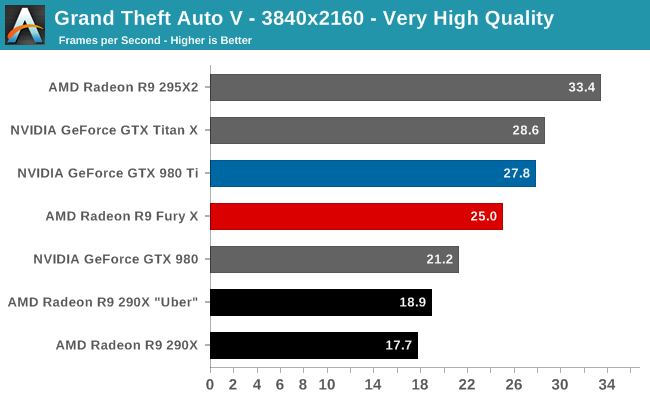
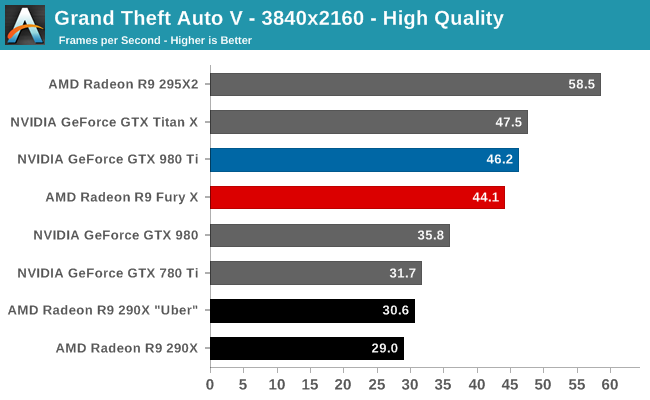
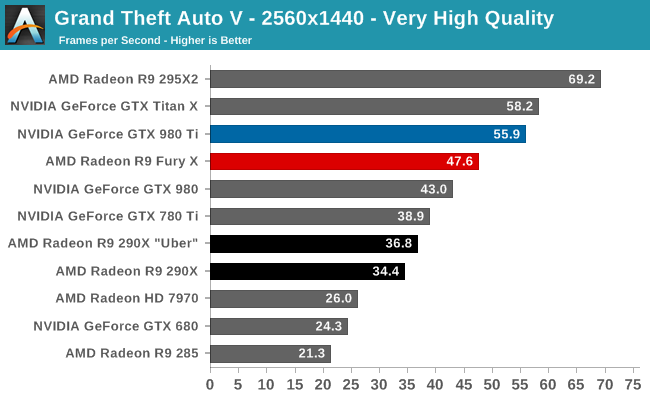
Our final game sees the R9 Fury X go out on either an average or slightly worse than average note, depending on the settings and resolution we are looking at. At our highest 4K settings the R9 Fury X trails the GTX 980 Ti once again, this time by 10%. Worse, at 1440p it’s now 15%. On the other hand if we run at our lower, more playable 4K settings, then the gap is only 5%, roughly in line with the overall average 4K performance gap between the GTX 980 Ti and R9 Fury X.
In this case it’s probably to AMD’s benefit that our highest 4K settings aren’t actually playable on a single GPU card, as the necessary drop in quality gets them closer to NVIDIA’s performance. On the other hand this does reiterate the fact that right now many games will force a tradeoff between resolution and quality if you wish to pursue 4K gaming.
Finally, the performance gains relative to the R9 290X are pretty good. 29% at 1440p, and 44% at the lower quality playable 4K resolution setting.
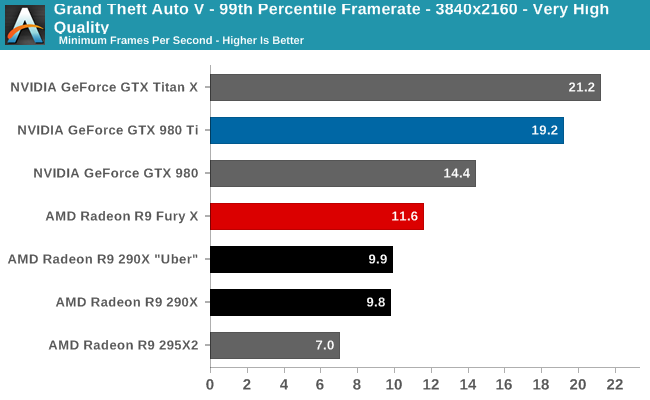
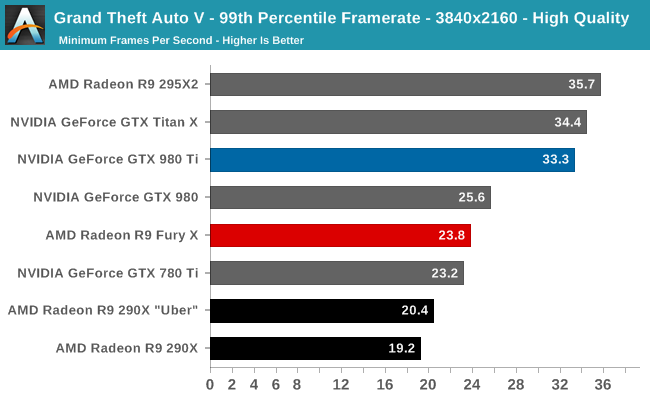
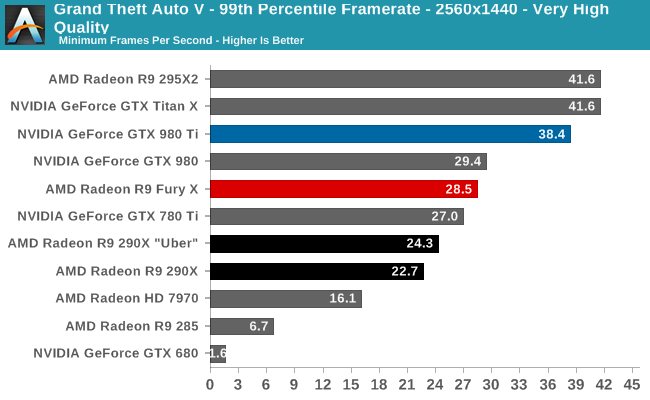
Shifting gears to 99th percentile frametimes however – a much-welcome feature of the game’s built-in benchmark – finds that AMD doesn’t fare nearly as well. At the 99th percentile the R9 Fury X trails the GTX 980 Ti at all times, and significantly so. The deficit is anywhere between 26% at 1440p to 40% at 4K Very High.
What’s happening here is a combination of multiple factors. First and foremost, next to Shadow of Mordor, GTAV is our other VRAM busting game. This, I believe, is why 99th percentile performance dives so hard at 4K Very High for the R9 Fury X, as it only has 4GB of VRAM compared to 6GB on the GTX 980 Ti. But considering where the GTX 980 places – above the R9 Fury X – I also believe there’s more than just VRAM bottlenecking occurring here. The GTX 980 sees at least marginally better framerates with the same size VRAM pool (and a lot less of almost everything else), which leads me to believe that AMD’s drivers may be holding them back here. Certainly the R9 290X comparison lends some possible credit to that, as the 99th percentile gains are under 20%. Regardless, one wouldn’t expect to be VRAM limited at 1440p or 4K without MSAA, especially as this test was not originally designed to bust 4GB cards.










458 Comments
View All Comments
OrphanageExplosion - Wednesday, July 8, 2015 - link
Anti-aliasing is required for the same reason that no AA still sticks out on 3D titles on an iPad, but in my experience with a 32-inch 4K Asus, post-process AA (SMAA, FXAA) does the job just fine.Oxford Guy - Thursday, July 9, 2015 - link
"the OS uses 3 GB to 3.5 GB"That's insane bloat.
Nerdsinc - Monday, July 13, 2015 - link
I sincerely hope the Overclocking limitations are related to software, a $1000 card with liquid cooling ought to be able to pull higher clocks than that...yhselp - Saturday, July 18, 2015 - link
Out of curiosity, is it really possible for an Xbox One/PlayStation 4 game to take up over 4GB of memory just for graphics, since just 5GB total are usable for games?Refuge - Thursday, July 23, 2015 - link
When ported to PC yes. That is because we usualyl get enhanced graphics settings that they do not.PC ports are also less efficient because of low budget ports. Which just compounds the issue more.
Computers have to be more powerful than their console counter parts in order to play equivalent games due to sloppy coding, and enhanced visual options.
ludikraut - Thursday, July 23, 2015 - link
Lack of HDMI 2.0 support totally kills the card for me. Who the heck wants to look at 4K at 30Hz? Guess I'll be sticking with my GTX 970 for a while.l8r)
eodeot - Friday, July 31, 2015 - link
You didn't even mention AMDs poor power consumption while idle with multiple monitors or while playing back a video of any kind.For some reason AMD thinks that playing back 240p Youtube video requires 3d clocks and thus 3d power consumption, even if the video is paused.
AMD failed to address it for the past 5 years and you failed to mention it yet again. Nvidia fixed this long ago...
JJofLegend - Friday, October 14, 2016 - link
I recently got an AMD Fury X, but I'm running into an issue with my games. I've tried with Battlefield 4, Crisis 3, Quantum Break, ReCore, The Division, and they all have the same distortion. Any ideas or anyone that can make suggestions? I don't know how to trouble shoot this.Here is a screenshot of Crisis 3:
https://vjkc5g-ch3301.files.1drv.com/y3m_mcTTTddOj...